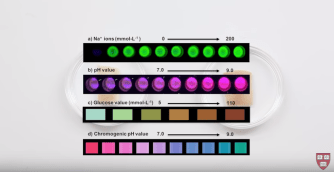What If Tattoos Gave You Updates about Your Health?

Sorry, Fitbit. We may soon have a battery-free wearable device that monitors your health–a bio-sensing tattoo.
Researchers at MIT and Harvard Medical School recently announced the development of the “Dermal Abyss,” a health-monitoring tattoo that can turn your body surface into an interactive display. It is a development that should excite biohackers and transhumanists, but also have potentially large mainstream applications.
By tattooing optical biosensors into the skin, the tattoo can react to changes in your body’s interstitial fluid. The Dermal Abyss may solve a major problem: how to create a health-monitoring tool that is easy to wear, bio-compatible, and has access to the relevant bio-markers?
The Need for Better Health Monitoring Tools
As we have seen in the market for wearable devices and other monitoring tools, there is a desire to measure glucose levels, blood pressure, skin temperature, and brain activity. While there are currently silicon-based implantable devices, these would not be considered bio-compatible. The implantable devices lack of smooth integration in one’s daily life also discourages its use.
According to the marketing research firm Kalorama Information, the market for health-monitoring wearable devices surpassed $13 billion in 2016. Despite their success, there have been major questions around the the merit of the data being tracked and shown to consumers. Popular wearable devices like Fitbit may give the impression of accuracy, but often do not have direct access to the relevant bio-markers. For example, a 2016 study by Ball State University found that the Fitbit Charge HR often missed heartbeats. In the study, the device had an average heartbeat error of 14 percent.

How Does the Dermal Abyss Work?
The Dermal Abyss works by swapping out the traditional inks of tattoos with bio-sensing inks. These bio-sensing inks alter color in response the the intestinal fluid. As the picture above shows, the pH sensor changes colors for indicators such as glucose, sodium, and fluoresce. While some color changes could be noticed by the naked eye, other color changes would be seen by using a blue light. The Dermal Abyss was developed as a proof of concept, being made on pigskin. In order for a health-monitoring tattoo to be ready for market, more durable inks that do not fade as quickly would need to be developed.
“By featuring tissue cells with interactive properties, the skin can change its color, light intensity, or structure to display information. Hence, the skin cells become a pixel screen to be decoded by the user, other viewers, or cameras.” -“The Dermal Abyss: Interfacing with the Skin by Tattooing Biosensors“
Will the Dermal Abyss Creep People Out?
While the visual of the tattoo altering color is griping, the possibility of health-monitoring tattoos doesn’t create the same level of unease for me that, let’s say, microchipping does. Whereas microchipping can cross the “cyborg threshold,” and offend the notions of our humanness, the Dermal Abyss builds on the body modification process of tattooing that has been done for thousands of years.
Where you for foresee unease with advances like the Dermal Abyss, however, is in the continued erosion with personal health indicators from something private to something made public. That tends to be our unease with how health-monitoring tools are utilized by empowers–transitioning from a well-intended incentive to be healthy, towards a more worrisome way to discriminate. Our personal health is something that we like to have full control over how–and with who–we share the information. One consideration of the Dermal Abyss is whether the color changes should be noticeable by the naked eye, or be more of an invisible ink where a special light is needed.
“The purpose of the work is to light the imagination of biotechnologists and stimulate public support for such efforts. These questions of how technology impacts our lives must be considered as carefully as the design of the molecular sensors patients may someday carry embedded in their skin.” –Nan Jiang, Harvard Medical School, who worked on the Dermal Abyss (speaking to the Harvard Gazette)
Our skin has always acted as an indicator to our underlying health, with subtle changes to color and temperature. Outside of the medical field, there was always a level of guesswork with the process (i.e. “Are you okay? You look sick today). It would be a whole lot more interesting if a person was literally wearing their health.





